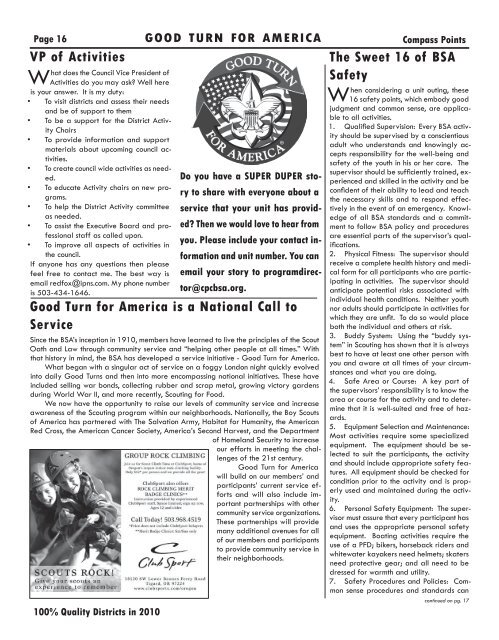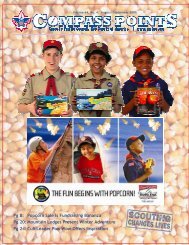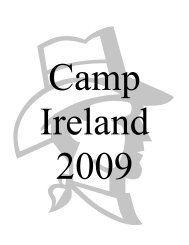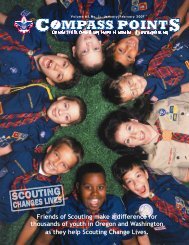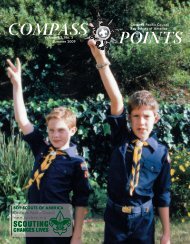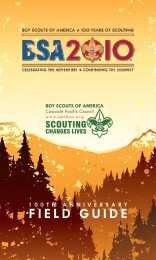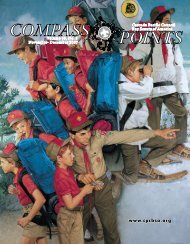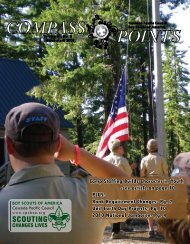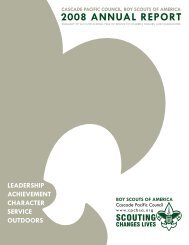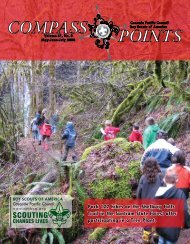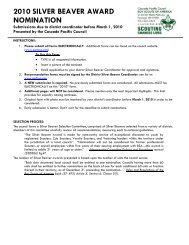7MB (PDF) - the Cascade Pacific Council Home Page!
7MB (PDF) - the Cascade Pacific Council Home Page!
7MB (PDF) - the Cascade Pacific Council Home Page!
Create successful ePaper yourself
Turn your PDF publications into a flip-book with our unique Google optimized e-Paper software.
<strong>Page</strong> 16<br />
VP of Activities<br />
What does <strong>the</strong> <strong>Council</strong> Vice President of<br />
Activities do you may ask? Well here<br />
is your answer. It is my duty:<br />
• To visit districts and assess <strong>the</strong>ir needs<br />
and be of support to <strong>the</strong>m<br />
• To be a support for <strong>the</strong> District Activity<br />
Chairs<br />
• To provide information and support<br />
materials about upcoming council activities.<br />
• To create council wide activities as needed.<br />
• To educate Activity chairs on new programs.<br />
• To help <strong>the</strong> District Activity committee<br />
as needed.<br />
• To assist <strong>the</strong> Executive Board and professional<br />
staff as called upon.<br />
• To improve all aspects of activities in<br />
<strong>the</strong> council.<br />
If anyone has any questions <strong>the</strong>n please<br />
feel free to contact me. The best way is<br />
email redfox@ipns.com. My phone number<br />
is 503-434-1646.<br />
100% Quality Districts in 2010<br />
g o o d tu r n fo r am e r i c a<br />
Do you have a SUPER DUPER story<br />
to share with everyone about a<br />
service that your unit has provided?<br />
Then we would love to hear from<br />
you. Please include your contact information<br />
and unit number. You can<br />
email your story to programdirector@cpcbsa.org.<br />
Good Turn for America is a National Call to<br />
Service<br />
Since <strong>the</strong> BSA’s inception in 1910, members have learned to live <strong>the</strong> principles of <strong>the</strong> Scout<br />
Oath and Law through community service and “helping o<strong>the</strong>r people at all times.” With<br />
that history in mind, <strong>the</strong> BSA has developed a service initiative - Good Turn for America.<br />
What began with a singular act of service on a foggy London night quickly evolved<br />
into daily Good Turns and <strong>the</strong>n into more encompassing national initiatives. These have<br />
included selling war bonds, collecting rubber and scrap metal, growing victory gardens<br />
during World War II, and more recently, Scouting for Food.<br />
We now have <strong>the</strong> opportunity to raise our levels of community service and increase<br />
awareness of <strong>the</strong> Scouting program within our neighborhoods. Nationally, <strong>the</strong> Boy Scouts<br />
of America has partnered with The Salvation Army, Habitat for Humanity, <strong>the</strong> American<br />
Red Cross, <strong>the</strong> American Cancer Society, America’s Second Harvest, and <strong>the</strong> Department<br />
of <strong>Home</strong>land Security to increase<br />
our efforts in meeting <strong>the</strong> challenges<br />
of <strong>the</strong> 21st century.<br />
Good Turn for America<br />
will build on our members’ and<br />
participants’ current service efforts<br />
and will also include important<br />
partnerships with o<strong>the</strong>r<br />
community service organizations.<br />
These partnerships will provide<br />
many additional avenues for all<br />
of our members and participants<br />
to provide community service in<br />
<strong>the</strong>ir neighborhoods.<br />
Compass Points<br />
The Sweet 16 of BSA<br />
Safety<br />
When considering a unit outing, <strong>the</strong>se<br />
16 safety points, which embody good<br />
judgment and common sense, are applicable<br />
to all activities.<br />
1. Qualified Supervision: Every BSA activity<br />
should be supervised by a conscientious<br />
adult who understands and knowingly accepts<br />
responsibility for <strong>the</strong> well-being and<br />
safety of <strong>the</strong> youth in his or her care. The<br />
supervisor should be sufficiently trained, experienced<br />
and skilled in <strong>the</strong> activity and be<br />
confident of <strong>the</strong>ir ability to lead and teach<br />
<strong>the</strong> necessary skills and to respond effectively<br />
in <strong>the</strong> event of an emergency. Knowledge<br />
of all BSA standards and a commitment<br />
to follow BSA policy and procedures<br />
are essential parts of <strong>the</strong> supervisor’s qualifications.<br />
2. Physical Fitness: The supervisor should<br />
receive a complete health history and medical<br />
form for all participants who are participating<br />
in activities. The supervisor should<br />
anticipate potential risks associated with<br />
individual health conditions. Nei<strong>the</strong>r youth<br />
nor adults should participate in activities for<br />
which <strong>the</strong>y are unfit. To do so would place<br />
both <strong>the</strong> individual and o<strong>the</strong>rs at risk.<br />
3. Buddy System: Using <strong>the</strong> “buddy system”<br />
in Scouting has shown that it is always<br />
best to have at least one o<strong>the</strong>r person with<br />
you and aware at all times of your circumstances<br />
and what you are doing.<br />
4. Safe Area or Course: A key part of<br />
<strong>the</strong> supervisors’ responsibility is to know <strong>the</strong><br />
area or course for <strong>the</strong> activity and to determine<br />
that it is well-suited and free of hazards.<br />
5. Equipment Selection and Maintenance:<br />
Most activities require some specialized<br />
equipment. The equipment should be selected<br />
to suit <strong>the</strong> participants, <strong>the</strong> activity<br />
and should include appropriate safety features.<br />
All equipment should be checked for<br />
condition prior to <strong>the</strong> activity and is properly<br />
used and maintained during <strong>the</strong> activity.<br />
6. Personal Safety Equipment: The supervisor<br />
must assure that every participant has<br />
and uses <strong>the</strong> appropriate personal safety<br />
equipment. Boating activities require <strong>the</strong><br />
use of a PFD; bikers, horseback riders and<br />
whitewater kayakers need helmets; skaters<br />
need protective gear; and all need to be<br />
dressed for warmth and utility.<br />
7. Safety Procedures and Policies: Common<br />
sense procedures and standards can<br />
continued on pg. 17


